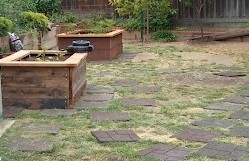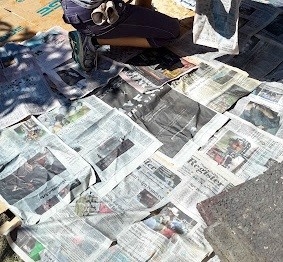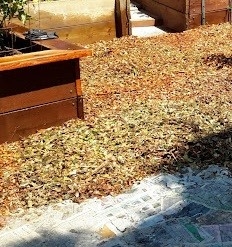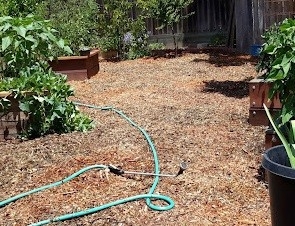Melody Kendall

This is the second of several blog posts presenting information about removing your lawn. This post will give a brief description about sheet mulching or lasagna composting.

-Cardboard: Large pieces of plain uncolored cardboard are best and can be cut down as needed but small pieces can be used as well. The object is to cover the entire project area with cardboard with nothing exposed. Remove any tape and staples as you apply the cardboard. If you miss any tape it will surface as the cardboard decomposes and can then be removed.

-Topsoil, compost, wood chips or rock as a topper:
For most future garden beds you would use topsoil or compost as a topper. In areas that are planned to be walkways or existing areas that have mature plantings, wood chips or some other kind of rock mulch can be used as the final step. Weed cloth is not recommended.
Area preparation:
-Mow or use a string mower to cut the vegetation as close to the ground as possible. Leave the trimmings in place as they will help with the decomposition.
-Dig a trench around the entire area to be sheet mulched about 4 inches deep and 6-8 inches wide. Evenly distribute the excavated soil up onto the trimmed vegetation within the prepped area. The trench will give you an ‘edge' to line up with and to tuck the cardboard into. This will facilitate making the final height of the successive sheet mulching layers the same as the height of the surrounding landscape. Avoid any lumps or overspill onto adjacent walkways.

1- Water the entire project area well and briefly loosen the soil lightly with a large garden fork before beginning
2- Lay out the cardboard abutting and down into the trench. Line each successive piece of cardboard edge to edge with about a 6 inch overlap. Cover the entire project area with overlapped cardboard.
3- Once the entire surface is covered with cardboard, spray it with water until it is wet.
4- Next, lay newspaper to cover the whole surface of the exposed, wet cardboard, again generously overlapping the layers about 6”. To prevent the newspaper from blowing around, dampen the newspaper before applying it to the cardboard surface. Then wet both layers, cardboard and newspaper, again.
5- Over the entire surface of the wet cardboard/newspaper layers spread a final layer of either compost, topsoil or your selected mulch, in at least a 3" deep final layer.
While the area is decomposing (1-3 months), water the area to keep it moist, but not as much as you would water a lawn — just enough to keep the layers wet and contacting the soil. This helps with decomposition.
If your goal is a walkway, or if you sheet mulched around existing plants your project is now complete. The decomposition of the layers will continue undisturbed. See accompanying pictures.

There are several different schools of thought on how to sheet mulch an area. The above directions describe just one method. Some lasagna composting directions suggest that you plant your large landscape plants before applying the cardboard. Others suggest that you cut holes in your completely sheet mulched areas and plant the large landscape plants right away. The addition of soil amendments before the application of cardboard is another suggested method. Do some research and you can tailor your efforts to best suit your needs. Knowing what you are doing before beginning will probably save labor and be the most successful.
The next lawn replacement post will feature information on two native grasses and grass-like plants suitable for achieving a water-friendly, low-growing, grass-like area — UC Verde Buffalo Grass and Kurapia.
Napa Master Gardeners are available to answer garden questions by email: mastergardeners@countyofnapa.org. or phone at 707-253-4143. Volunteers will get back to you after they research answers to your questions.
Visit our website: napamg.ucanr.edu to find answers to all of your horticultural questions.
Photo credits: Mel Kendall
Information links: Sheet Mulching: UC Master Gardeners of Butte County https://ucanr.edu/sites/bcmg/files/216158.pdf
UC Master Gardeners of Contra Costa County https://ccmg.ucanr.edu/files/221117.pdf